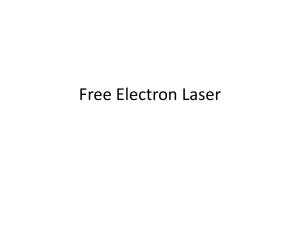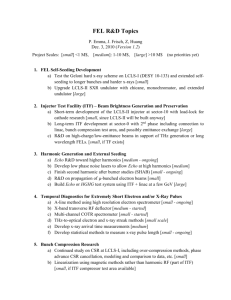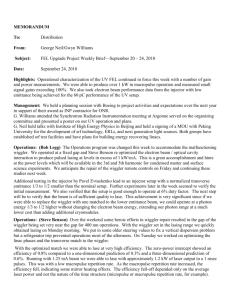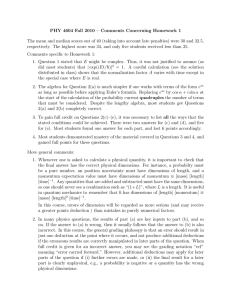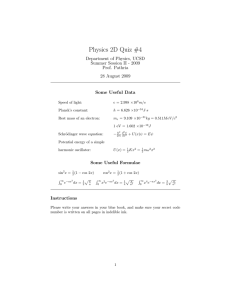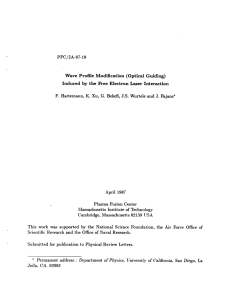PFC/JA-90-12 Observations of Periodic Intensity Bursts
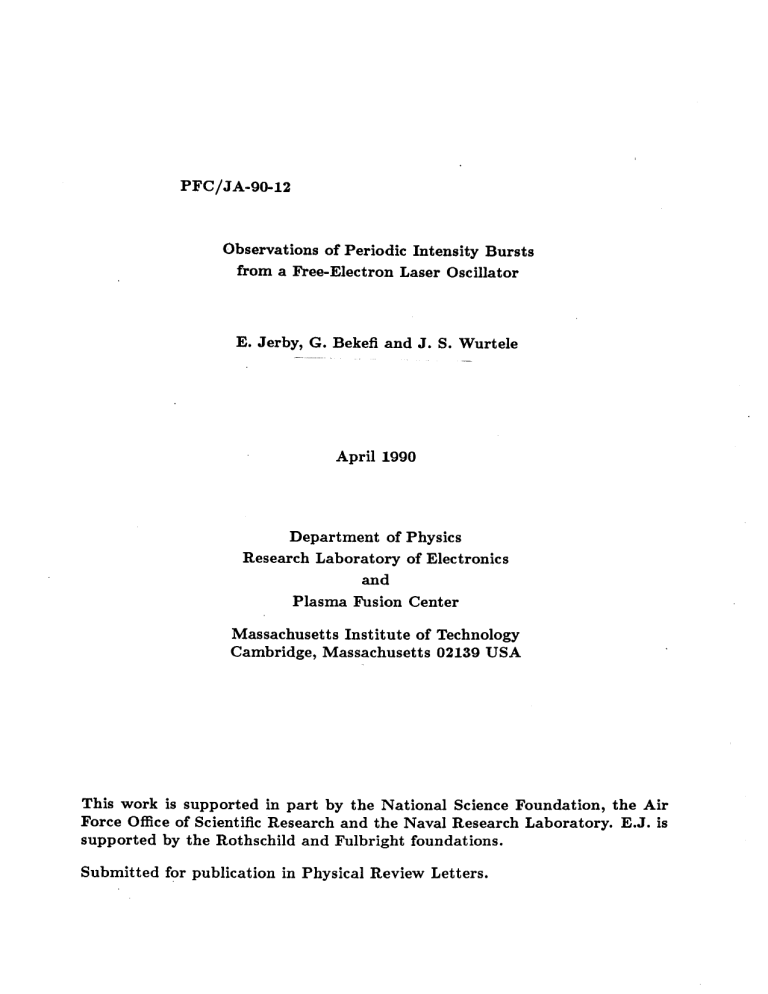
PFC/JA-90-12
Observations of Periodic Intensity Bursts from a Free-Electron Laser Oscillator
E. Jerby, G. Bekefi and J. S. Wurtele
April 1990
Department of Physics
Research Laboratory of Electronics and
Plasma Fusion Center
Massachusetts Institute of Technology
Cambridge, Massachusetts 02139 USA
This work is supported in part by the National Science Foundation, the Air
Force Office of Scientific Research and the Naval Research Laboratory. E.J. is supported by the Rothschild and Fulbright foundations.
Submitted for publication in Physical Review Letters.
Observations of Periodic Intensity Bursts from a Free-Electron Laser Oscillator
E. Jerbyt, G. Bekefi and J. S. Wurtele
Department of Physics
Research Laboratory of Electronics and
Plasma Fusion Center
Massachusetts Institute of Technology
Cambridge, Massachusetts 02139
Abstract
Observations of periodic intensity bursts from a free-electron laser oscillator operating in the microwave regime are reported. Their periodic separation
(~40 ns) equals the radiation round-trip time, and their width is approximately the slippage time (-2-4 ns). Unlike previous studies, the bursts occur in the small signal regime, near oscillation threshold. The observations are compared with theoretical results from an impulse response model of the freeelectron laser.
tPermanent address: Faculty of Engineering, Tel Aviv University, Ramat Aviv, 69978
Israel.
- 1 -
The study of the frequency spectrum and temporal evolution of electromagnetic pulses in lasers is a subject of considerable interest. In conventional atomic and molecular lasers short pulse phenomena have been known for many years. These include the nonlinear phenomenon of self (spontaneous) spiking' as well as a wide range of mode-locking mechanisms 2 and soliton formation.
3
In free-electron laser (FEL) oscillators, radiation bursts, or spikes, as they are often called, have been studied experimentally and theoretically in the nonlinear regime
by several groups.
4
~1
0 Their appearance comes about as a result of the FEL side-band instability caused by electron oscillations in the potential wells of the ponderomotive wave. In contrast, studies in this letter' 1 deal with the build-up of short electromagnetic pulses well before saturation and near oscillation threshold, where linear phenomena dominate the interaction. The observed spikes have a temporal separation corresponding to the radiation transit time (-40 ns) in the cavity, and their widths (2-4 ns) are believed to correspond to the slippage time between the radiation pulses and the electron bunches. Each assembly of micropulses is contained within a well-defined "macropulse" of about 1ys duration. Although the macropulses occur at random times, their appearance is correlated with observed random current spikes in the electron beam.
Figure la shows a schematic of our experiment.' 2
The accelerating potential is supplied by a Marx generator (Physics International Pulserad 615 MR). The electron beam is generated by a thermionically emitting, electrostatically focused, Pierce-type electron gun (250 kV, 250 A) from a SLAC klystron (Model 343). An emittance selector is used to limit the beam current to ~1 A. An assembly of focusing coils transports the electron beam into the rectangular stainless steel drift tube (0.40" x 0.90"), which also acts as the waveguide for the electromagnetic radiation. The beam is contained
by a uniform 1.6 kG axial magnetic field produced by a solenoid.
A 65 period circularly polarized magnetic wiggler has a period l = 3.5 cm,
- 2 -
an amplitude B, = 200-400 G, and is generated by bifilar conductors."-" Since an aperture limits the size of the electron beam to rb
-
0.071,, the wiggler field appears nearly sinusoidal to the drifting electrons. At the wiggler entrance a slowly increasing field amplitude is produced by resistively loading the first six periods of the wiggler magnet.
The 2.7 m long drift tube acts as a rectangular waveguide whose fundmental TE
10 mode has a cutoff frequency of 6.6 GHz. The drift tube closes upon itself and thereby forms a ring cavity 7.6 m in length (see Fig. la). The system is operated in a frequency range between 8 and 11 GHz. At those frequencies the empty waveguide can support only the fundamental (TE
1
0) mode, all higher modes being evanescent. The ring cavity loss is 5.5 dB. The single-pass FEL gain varies between 6 and 8.5 dB, so that the overall system gain is less than 3 dB. It is in this low net gain operating regime that all of our measurements are carried out, and where the periodic rf spikes are the clearest. In order to observe the rf spikes, the radiation field of the ring cavity is sampled by means of a 20 dB directional coupler and then measured with a calibrated crystal detector.
Figures lb and 1c illustrate the time history of the beam energy and rf power as observed on an oscilloscope screen. Since our Marx accelerator has an RC droop with a 25 its time constant, the electron beam energy sweeps through the range of values illustrated in Fig. 1b. Figure 1c shows that the overall rf pulse starts -7ps after the
Marx ignition and lasts typically for 1 to 3 ps.
Expanding the oscilloscope time scale yields the observed micropulses shown in
Fig. 2a. Placing a band pass filter (9.6-10.2 GHz) in the output arm of the directional coupler, reveals better the underlying micropulse structure, as illustrated in
Fig. 2b. The filtered pulse is seen to be composed of a sequence of partially overlapping macropulses with random start-up times. Each macropulse consists of a series of micropulses within a bell-shaped macropulse envelope. The distance between two successive micropulses is 36 ns, which is the ring cavity round-trip time of a micropulse with a center frequency of fo =9.6 GHz. The micropulse width is 2-4 ns, and no significant broadening is observed over many round-trips. Filtering the feedback signal by
- 3 -
a high-pass filter (f >9.6 GHz.), installed in the return leg of the ring cavity (instead of filtering the sampled signal) leads to similar results.
As noted above, each of the overlapping macropulses starts at a random time.
However, its appearance is correlated to spikes in the current density shown in Fig.
2c. The current density is measured by a tiny probe 1 3 partially inserted within the electron stream and placed ~1 m from the beginning of the bifilar helical wiggler (Fig.
1a).
The simplified linear model of the FEL oscillator in the time domain discussed below takes into account both the statistical features of the electron beam and the
FEL interaction. Random fluctuations of the electron beam initiate the oscillation process. They are described by a shot-noise model"~ in which the density ni (t) is given by ni (t) = n, + n, 6 (t - ti), (1a) where ti are random times distributed with a uniform density Ae; consequently 6(t
- t i
) are Poisson impulses. The correlation function of ni (t) is therefore given by
Rn(r) = n' (A2 + A, 6()). (1b)
In what follows we apply the shot-noise model to the current spikes shown in Fig. 2c, i.e., to macroparticles rather than to single electrons. The average temporal density of the spikes is Ae ~ 5ps~
1 as evaluated from experiments.
The FEL oscillator is modeled as a cascade of FEL blocks 17 as shown in Fig.
3. Each stage I in the cascade represents one round-trip time rd, where D is a delay element equivalent to the feedback waveguide section. Each FEL block (FEL 1
)) has two inputs, one for the EM wave Ej, and the other for the electron beam density fluctuations ni. Due to the voltage droop in the electron beam, each FEL block has different parameters determined by their instantaneous values at t = Irj. We assume that these parameters are almost stationary during one round-trip. The round-trip period is updated in each round-trip according to the instantaneous center frequency
- 4 -
(w) and the two independent inputs, EZ (w) and hi (w). These are given, in the frequency domain, for each FEL block (1) by
Eo(W) In=o T(l) (w)Ei(w) (2a)
E
0
(w)|Ei=o = T(') (w) hi(w). (2b)
The transfer functions TE (w) and Tn (w) are found from the gain-dispersion equations for the pre-bunched FEL.' 8
The response in the time domain of the FEL oscillator to a single density impulse, given by n(t) = no + nn6(t) for nrd < t < (n + 1)rd, is found by an inverse Fourier transform on the cascade transfer function hosc(t,ti = 0) = jT
)(w) JTU(w)ewtdw. l=1
(3)
The intensity of the impulse response jhoSc(t, t
1
= 0)2 is computed for the parameters of the FEL used in the experiment and is shown plotted as a function of time in Fig. 4a.
Figure 4b shows the corresponding frequency sweep due to the change in accelerator voltage shown in Fig. 1b. The first micropulse is the instantaneous response of the FEL to the electron beam impulse, and is esentially the time-domain representation of the
FEL spontaneous emission induced by the density fluctuations. The width of the first micropulse is comparable with the FEL slippage time, 1 9
[(l/vg) (1/v.)] Lw, where
Vg is the radiation group velocity, v, is the axial electron beam velocity and L, is the wiggler length. It is found both analytically and numerically that the tendency of the micropulse to broaden, due to the waveguide dispersion, is balanced by the FEL gain and phase shift. Consequently, the micropulse width is preserved in many round-trips.
This confirms our experimental results, in which no significant micropulse broadening is observed.
The theoretically calculated impulse response intensity of the FEL oscillator shown in Fig. 4a is quite similar to the bell-shaped macropulses measured in the experiment, shown in Fig. 2b, as is the periodic micropulse structure.
5 -
In conclusion, we have reported what we believe are entirely new observations of an FEL operating near oscillation threshold. The observations show that the radiation field is composed of bursts with a periodic substructure correlated to bursts in the electron beam current. These studies may lead to a better understanding of the FEL oscillator start-up phase and to methods of generating very short, tunable micropulses in free electron lasers.
ACKNOWLEDGEMENTS
This work is supported in part by the National Science Foundation, the Air Force
Office of Scientific Research and the Naval Research Laboratory. E. J. is supported by the Rothschild and Fulbright foundations.
- 6 -
References
1. P. W. Smith, IEEE J. Quantum Electron., 3, 627, (1967).
2. P. W. Smith, Proc. IEEE, 58, 1342 (1970); for recent studies on ultrafast laser phenomena, see the special issue of IEEE J. Quantum Electron., 25 (1989).
3. L. F. Mollenauer and R. H. Stollen, Opt. Lett., 9, 13 (1984)
4. N. M. Kroll and M. N. Rosenbluth, in Physics and Quantum Electronics
(Addison-Wesley, Reading, MA, 1980), Vol. 7, p. 147.
5. R. W. Warren, B. E. Newnam, and J. C. Goldstein, IEEE J. Quantum Elec-
tron., 21, 882, (1985).
6. J. Masud, T. C. Marshall, S. P. Schlesinger, and F. G. Yee, Phys. Rev. Lett.,
56, 1567 (1986).
7. W. B. Colson, Nucl. Instrum. Methods Phys. Res., A250, 168 (1986).
8. J. C. Goldstein, B. W. Newnam, R. W. Warren, and R. L. Sheffield, Nucl.
Instrum. Methods Phys. Res., A250, 4 (1986).
9. B. A. Richman, J. M. J. Madey, and E. Szarmes, Phys. Rev. Lett., 63, 1682
(1989).
10. J. W. Dodd and T. C. Marshall, in FEL '89 Conference Digest,
1 1 th
It.
Conf. on Free Electron Lasers, Naples, Florida, L. R. Elias and I. Kimel, Eds.,
IEEE-LEOS 1989.
11. E. Jerby, J. S. Wurtele and G. Bekefi, Bull. Am. Phys. Soc., 35, 1026 (1990).
12. J. Fajans, G. Bekefi, Y. Z. Yin, and B. Lax, Phys. Fluids, 28, 1995 (1985).
- 7 -
13. K. Xu, G. Bekefi, and C. Leibovitch, Phys. Fluids, Bi, 2066 (1989), and references therein.
14. H. A. Haus, IEEE J. Quantum Electron., 17, 1427 (1981).
15. P. Sprangle, C. M. Tang, and I. Bernstein, Physical Review A, 28, 2300 (1983).
16. K. J. Kim, Phys. Rev. Lett., 57, 1871 (1986).
17. A. Gover, H. Freund, V. L. Granatstein, J. H. McAdoo, and C. M. Tang,
Infrared and Millimeter Waves, vol. 11, ch. 8, K. J. Button, Ed., New York,
Academic, 1984.
18. I. Schnitzer and A. Gover, Nucl. Instrum. Methods Phys. Res., A237, 124
(1985). For a 2D derivation of Eqs. (4a,b), see E. Jerby, "Angular Steering of the FEL Far-Field Radiation Beam," to be published in Phys. Rev. A.
19. R. Bonifacio, C. Maroli and N. Piovella, Optics Communications 68, 369
(1988).
- 8 -
Figure Captions
Figure 1 (a) Experimental arrangement showing the ring cavity of the FEL oscillator; (b) and (c) are typical oscilloscope traces of the beam voltage and a radiation burst, respectively.
Figure 2 Expanded oscilloscope traces of typical radiation bursts before (a), and after (b) filtering (see text); (c) typical bursts in the electron beam current density.
Figure 3 Schematic of the computational model of the FEL oscillator.
Figure 4 (a) The computed impulse response of the FEL oscillator (to be compared with the experimental result in Fig. 2b), and (b) the corresponding center frequency associated with each pulse.
- 9 -
WAVEGUIDE
TO
ACCELERATOR
X-STAL DETECTOR
TO
OSCILLOSCOPE
DIRECTIONAL
/COUPLER
SOLENOID
L/\,//\ \//\/\/\/\/\\/\/
BIFILAR HELICAL
WIGGLER
:
THERMIONIC
PIERCE GUN I~a-2.25
(a) m.
V
[kV]
200t
CURRENT
MEASURING
PROBE
1004 p
[w]~ "
401
20-
I
8
I I I I I I
16 24 32
(b)
I t ly sl
~
I
I
I
I
16
'
24
(c)
I I I I
32
I t, S]
Fig.1 Jerby, Bekefi, Wurtele
-10-
V)
-11-
I[n s]
Fig.2 Jerby, Bekefi, Wurtele
-0
LLLU
Ua)
LU
LIi.
U..
a a) a)
4
-12-
(a)
0.6-
.)1
04-
0.2-
0.0-
76 f p
A~~~~~ p
7.8
..
1
8.0
II
**!
8.2
I-
8.4
f
[GHz]
10.2-
0
10.0 -
*.
9.8-
9.-
V.1
1
7.6
*
78
-13-
8.0
8.2
t LS]
8.4
b
Fig.4 Jerby, Bekefi, Wurtele
